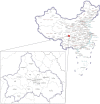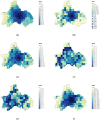Impact of urban spatial structure elements on carbon emissions efficiency in growing megacities: the case of Chengdu
- PMID: 37336925
- PMCID: PMC10279684
- DOI: 10.1038/s41598-023-36575-6
Impact of urban spatial structure elements on carbon emissions efficiency in growing megacities: the case of Chengdu
Abstract
Quantitative research on the impact weight and impact of regional heterogeneity of urban spatial structure elements on carbon emissions efficiency can provide a scientific basis and practical guidance for low-carbon and sustainable urban development. This study uses the megacity of Chengdu as an example to measure and analyze the spatial carbon emission efficiency and multidimensional spatial structure elements by building a high-resolution grid and identifying the main spatial structure elements that affect urban carbon emissions and their impact weights via the Ordinary Least Squares regression (OLS) and Geographically Weighted Regression (GWR). The spatial heterogeneity of the impact of each element is also explored. The results show that the overall carbon emission efficiency of Chengdu is high in the center and low on the sides, which is related to urban density, functional mix, land use, and traffic structure. However, the influence of each spatial structure element is different in the developed central areas, developing areas of the plain, mountainous developing areas, underdeveloped areas of the plain, and mountainous underdeveloped areas. Thus, it is appropriate to form differentiated urban planning strategies based on the characteristics of the development of each zone. The findings provide inspiration and a scientific basis for formulating policies and practice to the future low-carbon development of Chengdu, while provide a reference for other growing megacities.
© 2023. The Author(s).
Conflict of interest statement
The authors declare no competing interests.
Figures










References
-
- Cai M, et al. The need for urban form data in spatial modeling of urban carbon emissions in China: A critical review. J. Clean. Prod. 2021;319:128792. doi: 10.1016/j.jclepro.2021.128792. - DOI
-
- Newman PWG, Kenworthy JR. Gasoline consumption and cities. J. Am. Plann. Assoc. 1989;55:24. doi: 10.1080/01944368908975398. - DOI
-
- Ma J, Zhou S, Mitchell G, Zhang J. CO2 emission from passenger travel in Guangzhou, China: A small area simulation. Appl. Geogr. 2018;98:121. doi: 10.1016/j.apgeog.2018.07.015. - DOI
-
- Makido Y, Dhakal S, Yamagata Y. Relationship between urban form and CO2 emissions: Evidence from fifty Japanese cities. Urban Clim. 2012;2:55. doi: 10.1016/j.uclim.2012.10.006. - DOI
-
- Liu X, Sweeney J. Modelling the impact of urban form on household energy demand and related CO2 emissions in the Greater Dublin Region. Energy Policy. 2012;46:359. doi: 10.1016/j.enpol.2012.03.070. - DOI
Grants and funding
LinkOut - more resources
Full Text Sources

